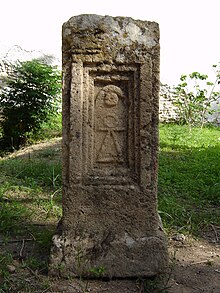Tanite


Tanit ( tnt , also Tannit , Thanit , Tinnit ) is the Punic goddess of fertility , patron goddess of Carthage . Her nickname is "Complainant in the face of Baal ". She was the main female deity of Carthage and replaced Astarte in this role . She is considered a virgin, but also the mother of Baal. As the giver of fertility, she has the name " Nutrix " (= wet nurse, breadwinner ). Every year it brings the fertility god Baal back to life. Her attributes are pomegranate, fig, ear of wheat and the dove. Its symbol is the Tanit sign: a triangle with a horizontal bar above it, on which a disk lies. She is also likely to be the woman depicted on Carthaginian coins from the 3rd century BC onwards. Be. The etymology of the name is controversial.
Originally a lower earth deity, Tanit and Baal-Hammon dissolved in the 5th century BC. Chr. Astarte and Melkart as the main gods of the Punians.
Human sacrifice
Children are said to have been sacrificed to Tanit in the fire (see also Moloch and Human Sacrifice). According to more recent findings, however, this could also be Roman war propaganda. Under stone steles, urns with charred children's bones were actually found, which for many researchers is evidence of child sacrifice. The archaeologist Fethi Chelbi sees it differently: "Today we believe that the tophet is more of a kind of cemetery for children. Analysis of the ashes from the urns showed that they came mainly from fetuses and stillbirths. At that time there was a high Child mortality - however, child graves are very rare in the cemeteries of Carthage. From this we conclude that the Tophet is a very special cemetery. This is where the deceased children were returned to the gods Baal Hammon and Tanit. "
Equations
Tanit was worshiped until the fall of the Phoenician culture. As Dea Caelestis lunare she is depicted on votive steles. In a small sanctuary found by Carton in Carthage in 1916, a cella , the god Hermes is immortalized on a statuette, who leans with his back on the throne of Tanit / Caelestis. This cella was uncovered during the construction of the Salammbô station, but fell victim to the construction of the railway after some artifacts were recovered. The Romans equated her with Ops and Nutrix , the nurse of Saturnus , the Greeks with Artemis, the goddess of hunting and fertility . In certain representations it also corresponds to Venus lugens.
cult
The name Tanit cannot be traced in the Phoenician motherland. Their veneration has also been proven in Malta . Particularly long, the Tanit cult held on the Balearic -Insel Ibiza where goddess long after the Christianization of the island's population in the second century was revered n. Chr.. Several places of worship have been excavated in Ibiza. The best known is the Es Culleram cave near Sant Vicent de sa Cala .
reception
The Tunisian ferry Tanit was named after her.
literature
- Antonio Planells Ferrer: El Culto a Tanit en Ebysos. Editorial LA Hormiga DE ORO, SA Barcelona 1970, OCLC 13139691 .
- E. Lipinski: Dieux et déesses de l'univers phenicien et punique. (= Studia Phenicia. XIV). Utgeverij Peeters & Dpartement Oosterse Studies, Leuven 1995, ISBN 2-87723-190-9 .
Web links
Individual evidence
- ↑ See also the study by JH Schwartz, F. Houghton, R. Macchiarelli, L. Bondioli, Skeletal Remains from Punic Carthage Do Not Support Systematic Sacrifice of Infants. In: PLoS ONE. Volume 5, No. 2, 2010, Article e9177. doi: 10.1371 / journal.pone.0009177 .
- ↑ L. Carton: Un sanctuaire punique découvert à Cathage. Paris 1929.
- ^ Gilbert and Colette Charles-Picard: Carthage - Life and Culture. Reclam, Stuttgart 1983, original title: La Vie quotidienne à Carthage au temps d'Hannilbal. Librairie Hachette, Paris 1958, 1982, pp. 51, 53, 86 f.

